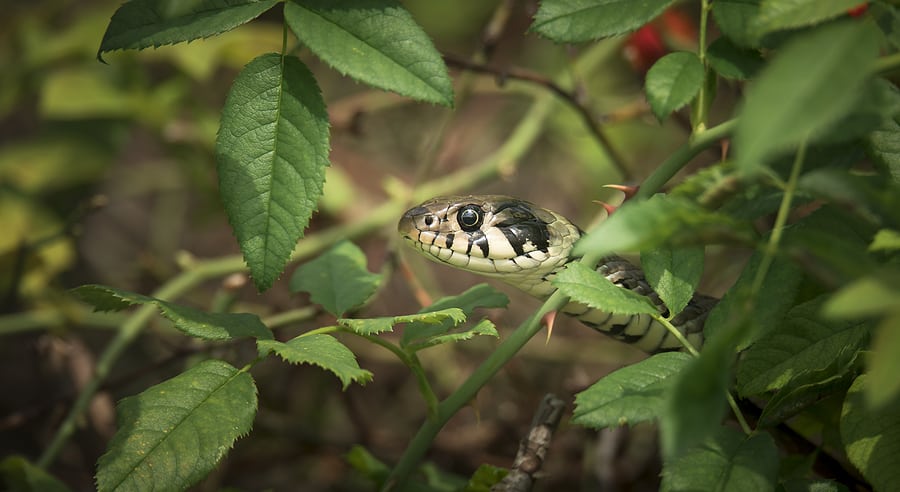What Attracts Snakes to Your Yard?
May 12, 2022 | Pest Control
With warm weather here to stay in the South, snakes are out in full force. Spring marks the beginning of snake season as they emerge from their winter dens in search of food. While most snakes are harmless (there are only a few venomous snake species in Georgia), it can be disconcerting to come across one in your yard.
What many homeowners don’t realize is that they could be inadvertently attracting snakes to their property. Here are some of the most common things that attract snakes to your yard along with some ways to prevent them.
Food Sources
Snakes typically eat a few times per week when food sources are available. While their diet varies by species, most snakes feed on small rodents (like mice) and birds. Having an abundance of these favorite foods around your home will draw snakes to your yard.
- Inspect your yard for signs of rodents. Because they are usually not seen during the day, these pests can be present without you even realizing it. Look for holes and burrows in the ground which they use to hide from predators. Sometimes you can even find droppings in your yard. If the population is large enough, you may even see visible tracks in the grass.
- Clean up your property. Don’t leave any old food or garbage lying around rodents can use to feed on. Clean up grills regularly and keep them covered, as well.
- Keep your lawn mowed and bushes and shrubs trimmed.
- Rodents will also hide in piles of wood or in sheds/garages. Block any entrances they can use to access exterior buildings. Keep wood piles covered and elevated.
- Bring in bird feeders overnight and clean up any spilled birdseed.
- Don’t leave pet food and water out overnight.
Water Sources
Snakes need water to survive. Some species even thrive in wet environments. Common water sources include rain puddles, water features, birdbaths, pools, and ponds/lakes.
- Birdbaths not only provide a source of water but they also attract birds, another common food source for snakes. If possible, raise your birdbaths and keep them farther away from your home.
- After a rainstorm, take note of where puddles form in your yard. Use dirt or soil to fill them in or even these low lying areas out.
- Keep pools maintained with appropriate treatments and cleaning.
- Lakes and ponds house fish, frogs, and birds which are another source of food for snakes. Trim the grass and plants around any bodies of water on your property. Consider building a small fence around it that snakes cannot climb over.
Ground Cover
Snakes will seek shelter wherever they can find it. Tall grass and overgrown shrubs provide the perfect cover for snakes from predators and also allows them to camouflage themselves when sneaking up on their prey.
- Keep landscaping maintained throughout the season.
- Keep grass mowed short. The blades of your grass should be short enough that they don’t arch over. This creates a tunnel snakes can use to move through.
- Use an edger or weedwhacker to trim tall grass and weeds from fence lines, as well.
- Avoid overwatering your lawn. Not only does overwatering make the grass grow faster and need to be mowed more often, it also attracts frogs, toads, and other pests that are a good alternative food source for snakes.
- Keep shrubs and bushes trimmed so that there is no contact between the shrubs and the ground. This helps eliminate hiding spots for snakes.
Cool Environments
Snakes are coldblooded and prefer to spend most of their time when not hunting in cool, dark, humid environments. This keeps them from overheating and allows them to cool off after a hunt. Snakes can often be found hiding in wood piles, bushes, garages, and sheds.
- Try to make these common hiding places less attractive to snakes.
- Keep open spaces cleared. Clean up woodpiles, debris, rock piles, pool toys and accessories, children’s toys, etc. Snakes will look for anything that can pile up and remain undisturbed to hide out in.
- Most snake species thrive when humidity is between 40 and 50%. Consider using a dehumidifier in garages and sheds to keep humidity levels lower.
- Check your foundations and the exterior of your home/other buildings. Gaps and cracks in foundations, exterior walls, garages, and sheds provide the ideal hiding spot for snakes. Repair gaps, cracks, and holes immediately.
Most snakes aren’t harmful to humans and, in fact, can be beneficial to have around as they help keep other pest populations under control. If you have a problem with snakes, contact your local pest control company for a snake removal and prevention plan that best suits your situation.
You May Also Be Interested In:
How to Avoid Stinging Insects at Home
How Fast Do Termite Treatments Work?
What Types of Grasses Work for My Georgia Lawn?
Controlling Birds During the Summer Months
Which Pests Are Active In Your Area?
